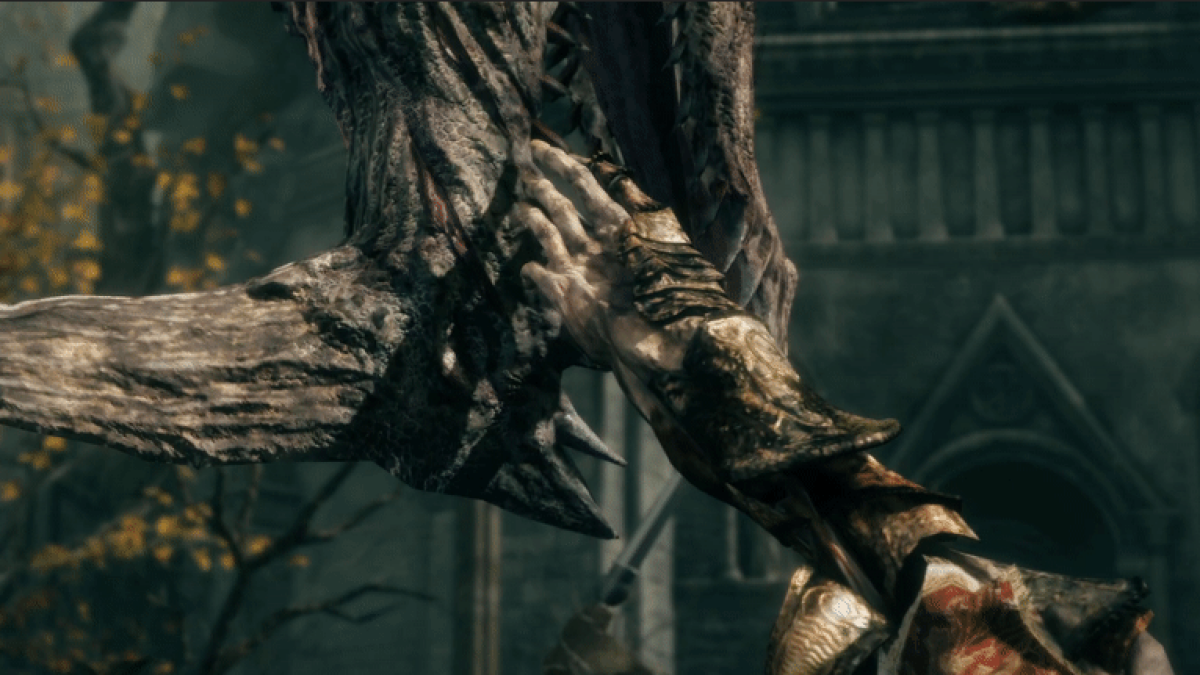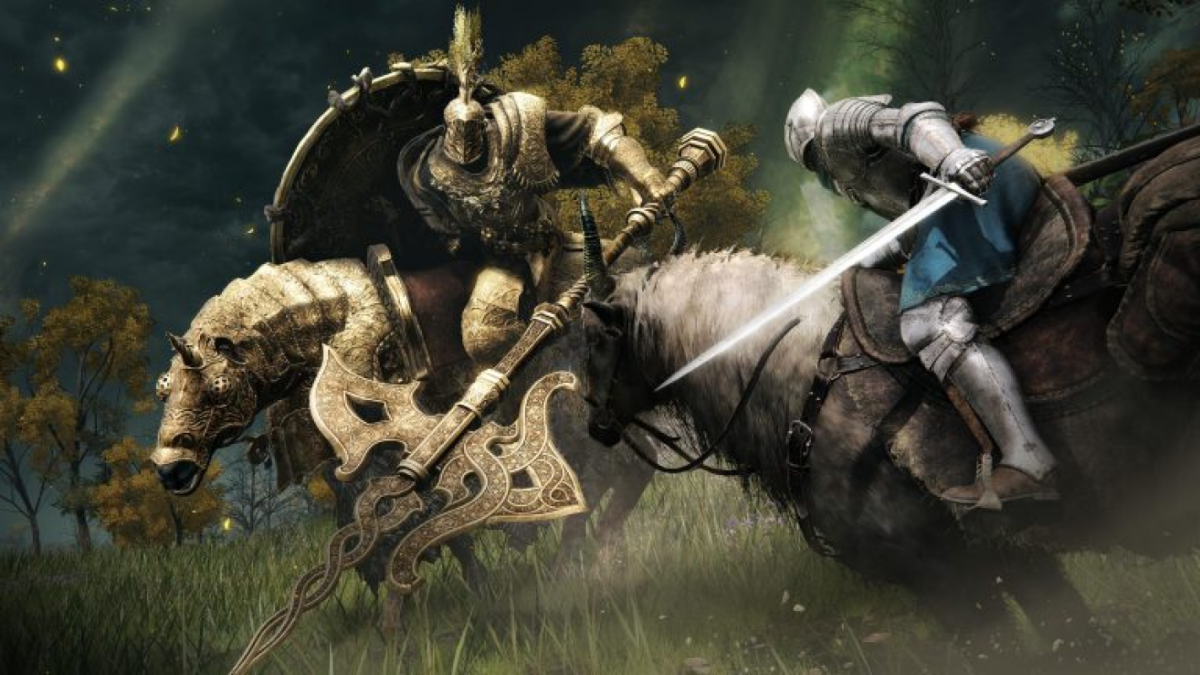Hello! I’ll be at The Game Developers Conference this week, so I’ll be very busy and taking a short time off. To those who read my scrawl, I super appreciate each and every one of you. See you in two weeks, with more to talk about, hopefully even stuff that isn’t about FromSoft games!… Maybe. Have a good one!
Month: March 2022
The Evolving Boss Design of Elden Ring: Godrick The Grafted
Yes, yet another FromSoft post. In my defense, Elden Ring, 2022’s action RPG release, and FromSoftware’s foremost foray into the open world game format is impossibly large, and has proven just as impossible to keep out of my head. Boss battles, with their big climactic set pieces and heightened sense of challenge have always been FromSoft’s bread and butter when it comes to their contemporary era of action games. It seems these games are constantly pushing the envelope of how grotesquely deadly these big baddies can be. The opening boss battles of Elden Ring are a strong showing, coming in with all the bombast, shock, and awe that I’ve come to expect, but I did notice something – a subtle shift in the design for the likes of Margit The Fell Omen and the first major ‘chapter boss’, so to speak, Godrick The Grafted. This new design direction seems to carry forward with the rest of the bosses of the game, so I really wanted to talk about it.

For those unfamiliar, combat in FromSoft RPGs generally can be broken down like this; The boss has a pool of attacks and moves from which they will select their action, reactive to the player character’s position relative to themselves. A dragon may swing its tail if the player is behind them, or breath fire if the player is standing at a distance, and such. In response, the player has a number of options including blocking with their shield, moving out of the way of the attack, or avoiding damage with the dodge roll maneuver, which gives the player a brief window of invincibility. The dodge roll is very very powerful, and potentially frees up a hand that would otherwise be occupied with a shield, so the player can two-hand a more powerful weapon, or offhand a second weapon. As such, the dodge roll is traditionally the player’s greatest tool of avoiding harm while they look for punishes, brief windows in which a boss cannot counterattack. These punishes happen when the end of a boss’s action animation precludes them from taking another action for a brief moment. The recoil of swinging a huge axe, for example.
Traditionally, FromSoft RPGs like Dark Souls and the like have a very powerful strategy when it comes to fighting bosses – getting behind them. Though even as far back as Demon’s Souls, many enemies were equipped with back-facing attacks meant to dissuade players from becoming too comfortable back there, the caveat was generally that these back-facing attacks were a lot more manageable than many of the front-facing ones, so circle strafing enemies remained a pretty dominant strategy in most situations, all the way up to Dark Souls 3, with some exceptions, but we’ll get to that.
When I first fought the major boss Godrick The Grafted I found myself failing and dying. A lot. To be expected of the infamously difficult FromSoft RPGs, right? Well sure, but Godrick is a very early game boss, so I had to rethink my approach. Surely the first major boss couldn’t be that difficult. Godrick’s fight is split into two phases, though both operate generally the same. He has a large pool of attack options, but I’ll mention some of the most common ones. First he has what I’ll call his basic attack combo, which he prefers to use on players that are standing medium-close to him, in front of him. It starts with a very slow axe swing to teach players to rely on their eyes for dodge cues, not just prediction, as aggressive predictions tend to result in early dodge rolls that are punished by such slow attacks. He’ll then follow up this axe swing with a series of swipes of his arms and axe, using a combo of variable length. If the player disengages, the combo stops at two attacks, but continues for up to four attacks if the player stays close.
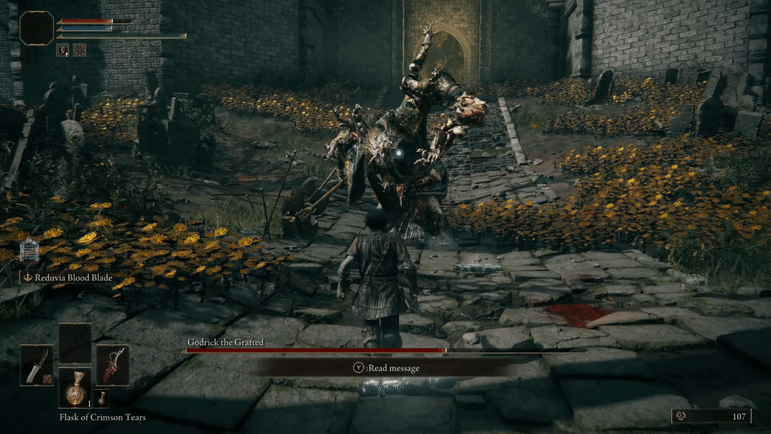
This attack presented a bit of a problem for my muscle memory. The dominant strategy of old in Dark Souls was to ‘dodge through’ enemy attacks. If you got the timing right, the invincibility of the dodge roll could carry you through the hitbox of an enemy sword swing, and the best way to do this would be to dodge into the arc of the swing, toward the direction it’s coming from. This minimizes the time your player character and the enemy hitbox intersect, making a successful dodge more likely. This results in a lot of getting behind enemies and proverbially hugging them up close. Try this on many of Godrick’s moves, however, and he’ll have a hasty response.
The better maneuver is to out-range Godrick, and dodge away from him as he attacks, dodging or moving toward him only to punish his openings, although these can be difficult to judge at first because he has so many followups. Remember how I said his basic attack has a variable length? Many many of Elden Ring‘s baddies have followups like that, contingencies to account for the different places the player might be standing to avoid harm, so sometimes what you think is a punishable opening on a boss is simply not.

Godrick’s ‘big swing’ attack, as I like to call it, happens when he rears up his axe with both hands slowly, giving the player ample time to reposition themselves in response. This attack has five very large swings, some of which hit in nearly 360 degrees. They’re also very deadly, making standing up close to him equally as deadly. This attack is very punishable, but only at the end of its run. Godrick has a lot of attacks like this, such has his whirlwind, which not only nudges players away in a circle around him with a bit of damage, but is immediately followed by one of two attacks that very difficult to distinguish without the full picture, and dodging the wrong one could mean taking a big hit. A lot of Godrick’s and many Elden Ring enemies’ moves are like this. They are of variable length, and potentially can sweep the player up in a very long combo. It’s not that getting behind a boss is impossible, it’s just not very safe.
Another feature worth mentioning, is the stagger system, somewhat borrowed from Sekiro. All enemies have an invisible value that is diminished when they take a hit, but constantly regenerates over time. If this value hits a certain minimum, the enemy will stagger, and become open to a critical attack. Due to its nature, and the many variables that go into it, this value can be somewhat unpredictable, especially as it is not displayed anywhere, unlike in Sekiro. Previous FromSoft RPGs had systems like this, though they were less powerful, only allowing an extra hit or two when enemies stagger, rather than a chance for big damage. Since the exact moment a boss will stagger is so unpredictable, the best thing to do is to just keep up the pressure, to increase your likelihood of getting a stagger, which naturally makes Elden Ring combat more aggressive and high-tension.
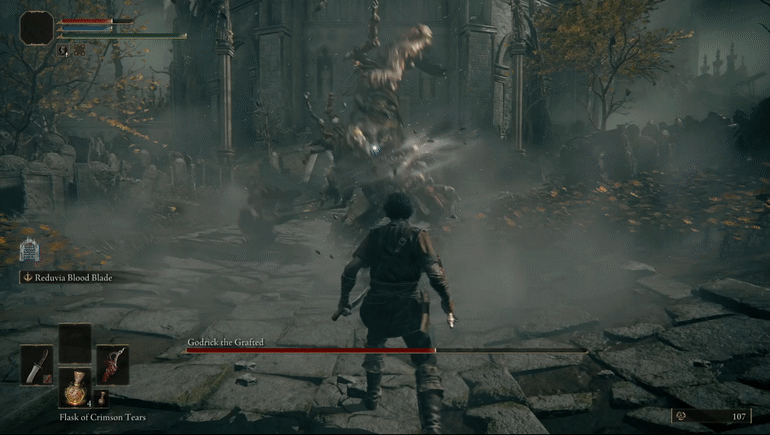
Frequently, if you do manage to get behind Godrick he’ll roll out of the way, and quickly prepare another attack. This often results in taking a hit, and disrupts your ability to consistently damage Godrick, meaning you’re less likely to stagger him with this route.
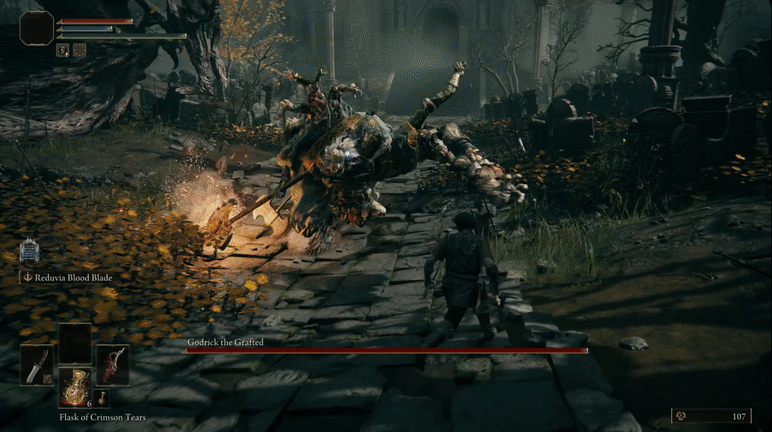
So what’s going on here? Why do the bosses in Elden Ring feel so different? I think I know. It seems to me that a major design goal for the bosses of Elden Ring ties into that verisimilitude I talked about when discussing Sekiro. FromSoft wanted fights in this game to feel more genuine, to reduce the friction between the gameplay and narrative of a life-and-death fight. In a real fight, you’d expect there to be a lot less dancing around opponents and a lot more squaring up, staring them down face-to-face, standing opposite one another as you trade blows. As such, everything about Godrick’s boss design makes him equipped to enforce that scenario. Getting behind him is dangerous, standing too close is dangerous, all defined by Godrick’s particularly designed behavior.
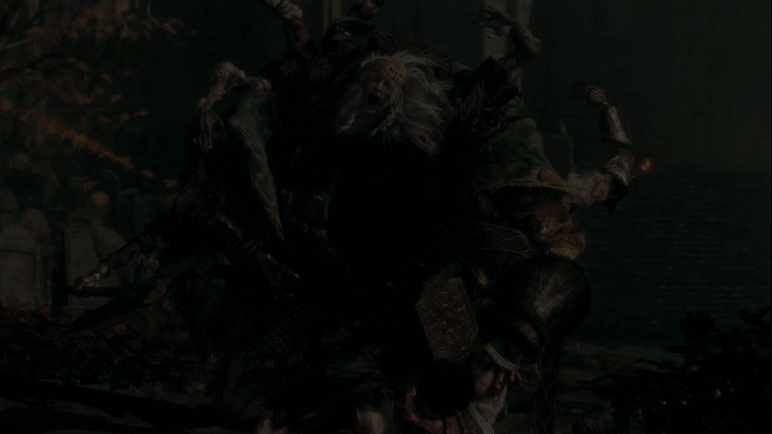
Between a much broader repertoire of tools at his disposal for hitting players at any angle, the ability to quickly reposition himself, and a much more unpredictable, variable moveset that adapts in length and reach to player positions in real-time, fighting Godrick the old way is much less viable. When players have to rethink their approach, they’ll likely come to a similar conclusion I did; the safest place to fight Godrick is in front of him, at a decent distance, where they can see his attacks clearly, and where dodging is less likely to be a death sentence. Compare Godrick to an early boss from the first Dark Souls game.
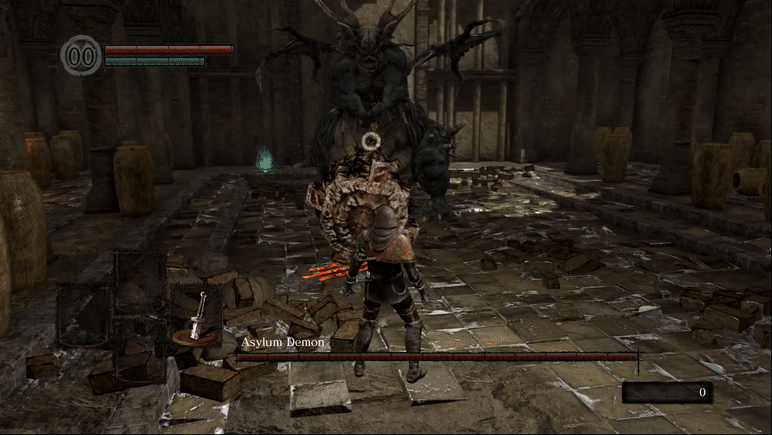
Notice how completely unable the asylum demon is to respond to my parking behind his rump. The Asylum demon does have an attack that can reach behind him, but it is exceptionally easy to dodge, with a huge slow windup. Also, it’s only just the one. Outside of trying to butt-stomp the player, the asylum demon really has no options. He can’t reposition himself either. Godrick, on the other hand, can… slam the ground to create a large earthquake in a circle around him, quickly whip up a whirlwing that knocks nearby players way, jump into the air to reposition himself and attack simultaneously, roll away to a more advantageous position, initiate his 5-hit super combo, etc.
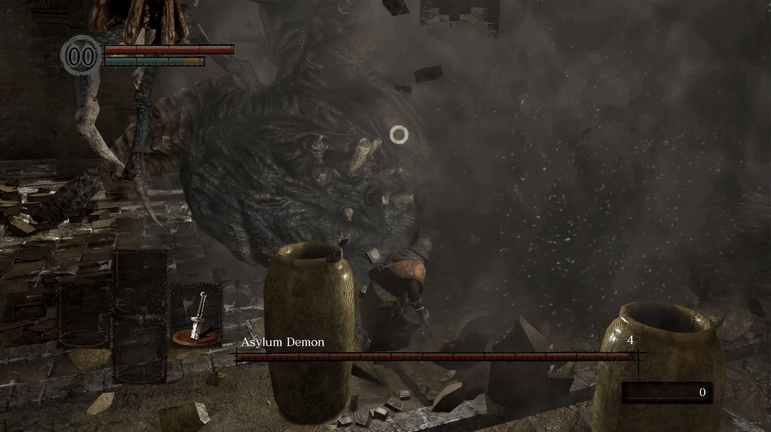
The old way of fighting bosses in Dark Souls was, and still is, fun. Some of the most fun I’ve had in a video game, but FromSoft isn’t a developer to rest on their laurels. The evolution of their boss design seems to be working more and more to create a believable experience with a strong sense of weight and presence. Verisimilitude is a major priority, but not only that, there are a lot of important advantages to designing bosses this way. For one, the player will be able to admire and appreciate the art of the boss they are fighting a lot more from a nice, framed, middle-distance shot, than from standing between their legs (depending on the boss, and the player, I guess..). The clearer framing also makes reading enemy telegraphs a lot clearer and easier. If a player is rightfully standing behind a boss because it’s the safest approach, camera zoomed up way close, they might understandably become frustrated by attacks they cannot see, and won’t determine the reason, succeeding by their strategy in the end, but having less fun in the process. Since so many of a boss’s attacks are triggered by the player position, having the player spend so much time in an awkward position may result in them not even seeing the boss’s coolest most impressive attacks, diminishing the entire set piece.
It seems FromSoft has been working toward this goal of the ‘squared off, face-to-face’ boss battle as a default for a long time. As far back as Dark Souls 2, we saw evidence of this. It is very popular to complain about the enemies’ ability in that game to track the player’s position with their attacks, meaning the enemy’s entire model actively rotates to align itself with player position, making circle strafing a weaker strategy. This worked to an extent, but also was pretty transparently artificial. People really just don’t move that way, spinning on their heel to align the swinging of their arms in a way that defied physics, so much so that my friends and I had taken to calling the process the ‘ballerina twirl’. Bloodborne reduced the ballerina twirling quite a bit, making up for it by giving the player a tool which made squaring up with bosses a lot safer – an extremely powerful frontal parry. Since the player needed their enemies to attack them from the front to succeed in a parry, it became a much more desirable spot to stand. The backstab of Bloodborne, being so slow, also meant circling around was suitable for stealth, but less suitable for active combat. Dark Souls 3 introduced a lot of the standard for how attacks are shaped in these games; big sweeping things that sometimes make as much as 360 degrees around the boss a danger zone. That game also introduced a lot of the adaptability and variability of enemy move-sets that made them more equipped to react to players constantly trying to get behind them.
This new design direction seems to have culminated in Sekiro, which was developed alongside Elden Ring. In Sekiro, parrying is everything, so enemies had to constantly be positioning themselves and the player into a squared off position. A lot of strategies employed to accomplish this seem to have carried over to Elden Ring, adapted to account for the lack of a strong parry, of course. The behavior of Sekiro‘s largest bosses is rather reminiscent of Elden Ring bosses. I can’t say I dislike this new direction FromSoft is taking its boss design. Godrick is a fun and exciting challenge, and one I actually got to see visually in its full glory! Just while recording footage for this post, I was struck by how consistently beautiful and exciting the action looked in motion, so by my estimation the efforts to make fights in Elden Ring feel more genuine, worked.
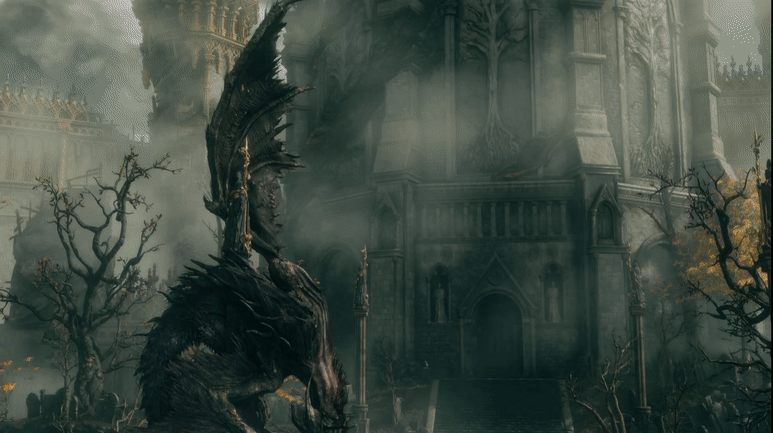
…And one day, we’ll return together …to our home, bathed in rays of gold…
Torrent of Elden Ring: Gaming’s Most Powerful Horse
My god, so that Elden Ring huh? Certainly has given me a lot to chew on. There are any number of topics I want to write about on that game eventually, from the new approach to boss design, to the integration of more summoned NPCs, the nuances of the tweaked melee combat, the expanded magic toolset, to how the open world has changed the way enemy encounters are designed. So I had to narrow it down, and I want to talk about one of the game’s most prominent new features and a major marketing point of the game – the presence of a horse and mounted combat.
I’ve wanted to, for a while now, do a write up on game design’s strange and somewhat hilarious history with mounted riding animals in a broader sense, but Elden Ring‘s local speedy boy Torrent has given me cause to talk about the ways Fromsoft has distinguished mounted combat and movement specifically. There are a lot of really cool design choices I’ve noticed that went into making Torrent a beast on the battlefield, with combat that feels as good as any of Fromsoft’s previous unmounted offerings. Here are just a few.
Don’t Forget, We’re Playing a Video Game
When I say ‘we’re playing a video game’ I don’t mean to say that player immersion and realism needs to go out the window. Kind of the opposite, actually. I feel like the tendency in some games is to put a lot of physics and terrain based restrictions on how player characters move. Maybe in the name of realism, maybe in the name of feeling cinematic, but often this approach leads to characters that control like tanks, ultimately creating more friction between the player and the experience, not less. My preference is to make the character controlling process as smooth as possible.
Torrent is a horse, and the design makes considerations to make his control feel more like a horse. He doesn’t stop on a dime. He’s got some acceleration and deceleration to him. He can’t turn on a dime, he needs space to swivel his rear around when you about face. Thing is, he doesn’t need that much space, and he doesn’t take that long to reach full speed or come to a stop. Torrent has movement limitations, but only barely enough to convince you he’s moving a like a horse. Fromsoft put the utmost priority into making sure he just moves smoothly, minimizing friction. Even given the very minor limitations placed on mounted movement to give the impression of riding a horse, enough to reinforce verisimilitude, these are somewhat circumvented by the presence of a double jump!
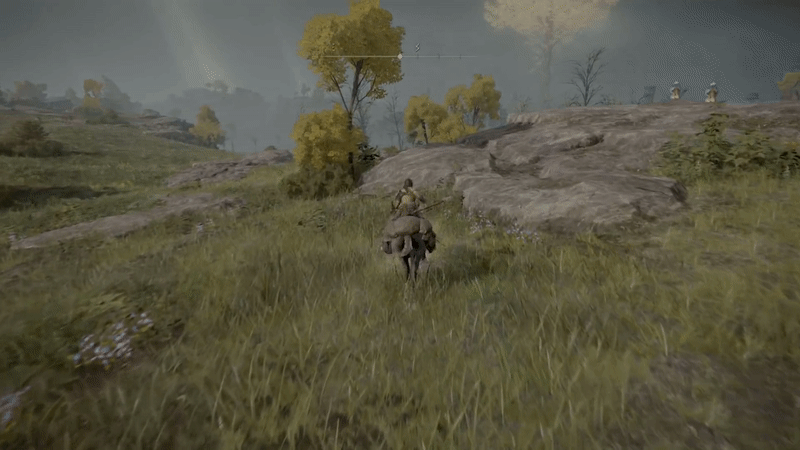
Yes, the horse can double-jump, completely redirecting his momentum in midair, enhancing the length and height of his jump in the process. Torrent doesn’t turn as hard as the player can on foot, but he can totally reorient himself by jumping. This mechanic is in place for several very important reasons. First, Torrent is an exploration tool and Elden Ring is filled with very precarious drops and complex terrain geometry. Something a lot of other games featuring horses have stumbled on is how damn incompatible the mounts are with their own game world. Lots of video game horses can move fast, but can’t go anywhere. A glut of limitations on mounted movement can make it too specialized and niche, not versatile enough to be used often.
Torrent doesn’t feel like a second entity your player is fighting to control, but rather an extension of themselves. In that way Torrent is treated more like a vehicle. It’s a compromise, in that this perhaps distances the design from the realism of riding a horse, but for the design goals they were trying to meet, it makes a lot of sense. Those design goals being, that riding Torrent needs to serve as a distinct combat style that feels as seamless and satisfying as grounded combat, an extension of Elden Ring‘s primary gameplay mode.
A Horse Is Much Faster Than You
This is a weird one to see not fulfilled so many times. Part of what makes Torrent so successful as a mount is that he is just a lot more maneuverable than you, the human player. He’s a horse; he can move at like double your top speed. I’ve played an astounding number of games with mounts that don’t feel all that much faster than just walking. The double jump plays into this too. Torrent has horns as well, kind of giving him the impression of a mountain goat, which communicates his exquisite climbing ability. Mountains, cliffs, and ravines are common obstacles in Elden Ring‘s world of the Lands Between. Distinguishing Torrent with his much more robust set of movements for dealing with such obstacles proves his worth to the player, and was very important in cementing his place in the game.
Torrent Isn’t Made of Paper
For a number of reasons, video game horses are often not equipped for combat. Perhaps the game simply does not have a design for mounted combat. Perhaps the design does not account for a constant companion that would throw off the game’s design. Maybe they just thought it’d be awkward if you constantly had a horse following you, biting and kicking goblins. Whatever the reason, horses in games often wind up very weak. Ride them off a two-foot-high outcropping and they crumple like they’re made of paper mache. Get jumped by a dragon, and you’re never seeing that horse again.
First of all, Torrent can fall very very far without issue. He needs to navigate complex environments with a lot of versatility and if he was constantly dying from underneath the player, it just would not be workable. Torrent has knees of steel, and can bound off of cliffs with ease.
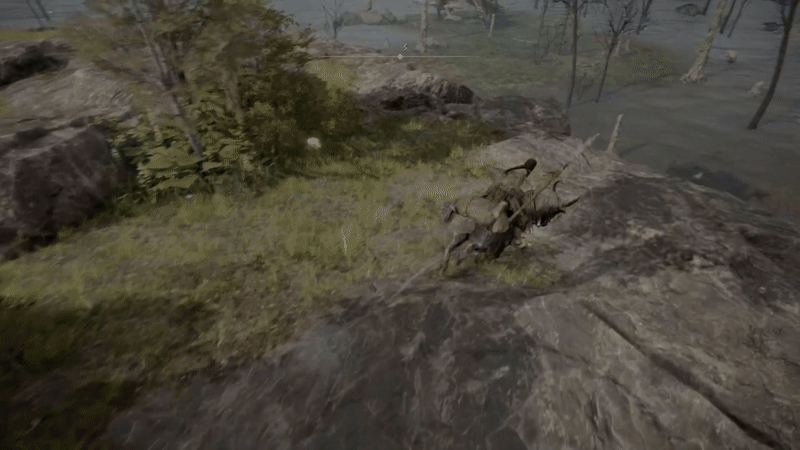
What’s more, Torrent is meant to be used in combat, and thus can take a hit or two. In fact, he’s quite a bit more sturdy than even the player. Riding Torrent is a very safe place to be, gameplay wise. He can even take hits for you, depending on the angle of attack. To counteract this big advantage, riding Torrent is given a specific risk. You can take a lot of hits, but if you are knocked off of Torrent, either by losing your balance, or if Torrent dies, you are sprawled onto the ground and left very vulnerable. Re-summoning Torrent will require taking a moment and possibly sacrificing some healing resources.
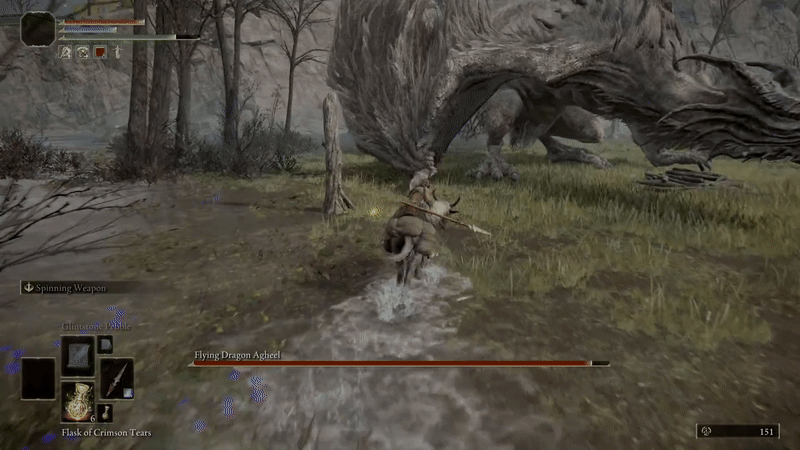
We’re Just Not Bothering With The Idle Problem
This one is funny to me, but I respect it. If you’ve played a video game with a horse you’ve seen it. The world’s jankiest implementation of entity spawning known to man. I’ve legitimately played a AAA game where I’ve seen a horse pop into existence upon use of the ‘horse summon’ button. The problem is, what do you do with mounted animals when they’re idling, not being ridden? Do they just run off somewhere? What’s the visual of that? How is the horse summoned and where does it come from? Does the horse exist in real-time, meaning it stays where you leave it until you come to pick it up? Torrent kind of just… double-jumps over this problem entirely. When summoned, he appears underneath your player in an instant, and disappears just as instantly when dismissed. Sometimes, the realism of a thing isn’t worth the headache. Torrent works better if his presence is never in question, so it just isn’t.
The side-benefit of this is that Elden Ring can switch between its two combat modes, mounted and on-foot on the fly and seamlessly. Torrent is always available outdoors if you need him. You can even ride Torrent into battle and jump off for a cool dismounting attack.
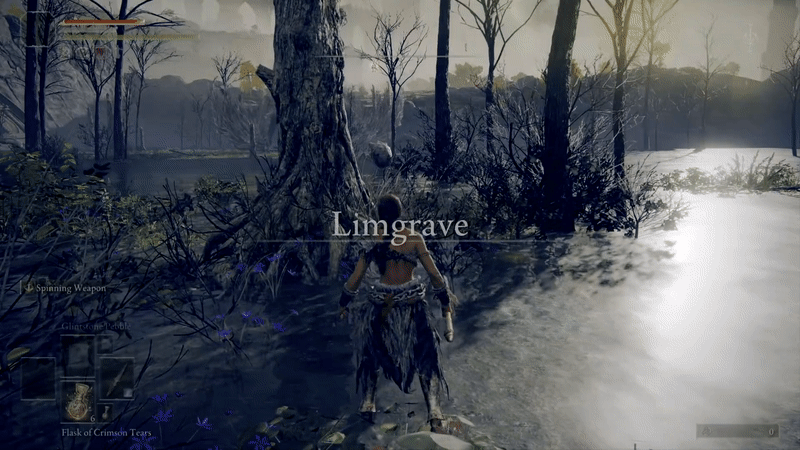
As Above So Below
This is a straightforward idea, but one that implies a lot of extra work in creating game assets. While mounted, the player is allowed to use basically any attack they can use while unmounted. Making the mounted combat feel seamless and parallel to unmounted combat was very important for Elden Ring, so a lot of extra animation and frame data was created to ensure the player’s preferred weapon and spells were available to them while mounted on Torrent as well.
Combat As a Spatial Problem
As I’ve said before, action combat is mostly all about relative spatial relationships between player and hazard. Where a player is standing when an enemy attacks determines if damage is dealt, etc. A friend of mine pointed out that video games are and have always been, very very good at mapping spatial problems, and with this in mind, real-time combat can often be boiled down to very elaborate spatial problem. Elden Ring‘s mounted combat leans hard into this concept. Normally, combat in Elden Ring and other action RPGs from Fromsoft centers majorly around the dodge roll mechanic, in which well timed button pressed can impart a moment of invincibility that can be used to circumvent damage regardless of positioning, although positioning remains important due to the invincibility window’s briefness.
Torrent does not have a dodge with invincibility frames, this seems to have been the main thrust of distinguishing mounted combat in Eldren Ring from its on-foot counterpart. There are other key differences, of course, but they all seem to revolve around this one major change. Having no iframes on Torrent changes the way one approaches combat immensely. ‘Rolling into’ attacks, so to speak, such that when a dodge roll ends, the enemy’s attack has already moved past the player’s position, is a fundamental strategy normally. But now, keeping your distance is a player’s best method for not getting hit. Since Torrent can’t dodge in the way the player can unmounted, dodging attacks becomes entirely a matter of positioning. In place of a dodge, Torrent has a dash which gives him a quick burst of speed, useful for getting player-seeking projectiles off your tail or outmaneuvering other mounted combatants. So you’re encouraged to always disengage after riding up to an enemy to hit them.

The result of this simple change is that combat much more resembles a series of ride-bys where the player rides up to their foe, hits them quickly, then circles behind or gets out of their reach in some way. There’s a lot of two horses riding past each other in a sort of joust… kind of like how mounted combat actually works, or at least how one might imagine it works! There’s that verisimilitude again! Dang. By removing this seemingly essential tool, Fromsoft has reinforced a method of gameplay that resembles what they are trying to simulate, brilliant! When you can’t dodge with invincibility, you have to outmaneuver danger, and that means riding around and past enemies like you’re an actual mounted cavalry, you can’t just stand squared up to your foe and hit them without expecting to get hit back, and thus you are encourage to be constantly on the move, kind of like you’re on a riding animal. Dang. It just keeps fitting together, doesn’t it?

So this is all well and good, but Elden Ring is an extremely three-dimensional game with a lot of danger happening, left, right, center, up, and down all the time. Torrent needed another tool to avoid damage. Dang, he already has one we’ve talked about, doesn’t he? The damn horse can double-jump. Torrent’s extreme level of vertical maneuverability makes awareness of enemy attacks even more essential, and some can be completely circumvented with well placed and timed jumps. Very little in this, or any video game feels as instantly exhilarating as jumping over a dragon’s flaming gullet, the camera pulled way out to capture the action. Forget harshly limited controls that make characters feel more ‘realistic’ or ‘cinematic’. No, good gameplay can do that just as well.

So yeah. Elden Ring impresses on a number of fronts, but it’s easily got the best mounted combat I’ve ever played. Not that I’ve played a huge number of mounted combat games, but riding Torrent is just as engaging as fighting enemies on foot, which is kind of impressive. The riding in and out to swipe enemies in the side as I pass, jumping over dragons, and covering great distances as I bound over cliffs, it’s all very exciting. Rarely have I had just a smooth experience with mounted animals in games. Fighting that dragon? Almost indescribable how elated I was, to fight a dragon that felt like it had an appropriate sense of danger, scale, and gravitas. Couldn’t have done it without you Torrent, here’s to many more adventures in the Lands Between.

Torrent has chosen you. Treat him with respect…
